Date : February 14 - 15, 2023
Report: Fukushima Press Tour Sponsored by the Ministry of the Environment, Japan
post date : 2023.04.05
As of this March, twelve years have passed since the Great East Japan Earthquake and the TEPCO Daiichi Nuclear Power Station accident. In Okuma, where Fukushima Daiichi is located, the town is being built up from zero in an unprecedented effort, and in Namie they are working to accelerate reconstruction by using renewable energy, as a town which suffered from a nuclear accident. The tour visited both these towns to cover the environmental restoration and reconstruction of Fukushima.
A total of eight journalists joined the tour, from media organizations based out of France, Germany, Portugal, Taiwan, and Turkey.
*This tour was sponsored by the Ministry of the Environment (MOE), Japan and planned and operated by the FPCJ.
*For more information on tour stops, see the tour notices here.
[Day 1]
<Ogawara, Okuma>
The tour visited the district of Ogawara, the headquarters for the town’s reconstruction, and received a briefing from a town official. The tour saw the new town, including newly built commercial facilities and post-disaster public housing, and the construction site for an educational facility planned to be completed this summer. The journalists asked questions about what percentage of residents returned after the evacuation order was lifted, what the current demographics of the town are, and whether the population was expected to increase in the future. They intently filmed and photographed the efforts to rebuild Okuma, which had its population drop to zero at one point after evacuation orders were given for the whole town.


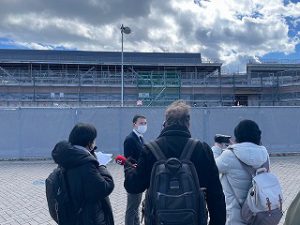

<Interim Storage Facility>
The tour visited the Interim Storage Facility, which was built to safely manage and store in a centralized location soil and radioactive waste removed as part of the decontamination process until its final disposal. After a briefing from a MOE Japan official at the Interim Storage Facility Information Center, the journalists took a bus around the Interim Storage Facility. As well as seeing the large container bags of removed soil being separated at the Soil Separation Facility from the bus, they also saw the Soil Storage Facility where numerous construction vehicles were being used to level the separated soil in a large area.
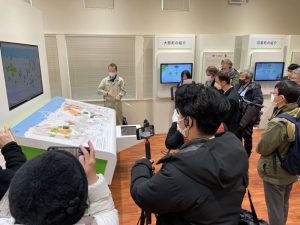


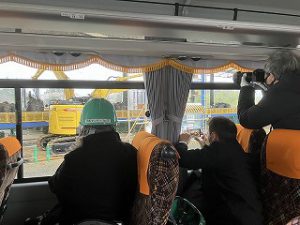
<Interview with Okuma’s Mayor, Mr. YOSHIDA Jun>
The tour heard from Mr. YOSHIDA Jun, the mayor of Okuma, about his appraisal of the current situation twelve years after the earthquake, when he expected the evacuation orders to be lifted for the remaining “Restricted area“, and plans to achieve the town’s goal of reaching a resident population of 4,000 by 2027. The journalists asked questions about the feasibility of the national government’s plan to achieve final disposal outside Fukushima Prefecture by 2045 for the removed soil being stored at the Interim Storage Facility, and his opinion on the government’s announcement of a guideline in December last year to use nuclear power plants as much as possible.

<Ministry of the Environment Briefing>
The tour listened to a briefing about the measures the MOE Japan has taken for Fukushima’s environmental restoration, including decontamination, the Interim Storage Facility, and research into ways to recycle the soil removed in the decontamination process. The journalists asked questions about the overall budget for the environmental restoration project, as well as whether the final disposal of removed soil outside the prefecture seemed likely to actually be completed by 2045, and its economic rationality.

<Interviews with Okuma Residents ①>
The journalists interviewed Mr. TAKEUCHI Kazushi, who reopened his café Rainbow for business in Okuma for the first time in ten years after the evacuation order for the Ogawara district was lifted in 2021. They asked questions such as what it was like in the café when the earthquake hit, what life was like while evacuated, and what made him decide to return to Okuma, as well as what he thought about the future of Okuma, such as what would happen with the Interim Storage Facility.
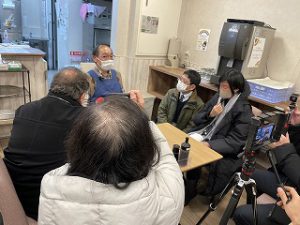
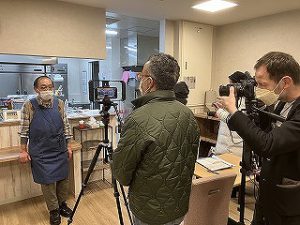
[Day 2]
<Biomass Resin Fukushima, Namie Plant>
The tour visited Biomass Resin Fukushima, which produces the environmentally friendly biomass plastic Rice Resin, made using ingredients such as rice made by local producers in fields which had been left unused in places including Namie. The journalists showed great interest as they filmed and photographed the plastic pellets being made from rice, and in addition to asking numerous questions about the production process and future business plans, they also heard from an employee who had returned to the town after having lived as an evacuee.

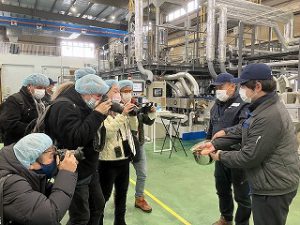
<Namie, Becoming a Hydrogen Town>
The tour visited the Fukushima Hydrogen Energy Research Field (FH2R), one of the largest hydrogen production facilities in the world, and in addition to being guided around the facility by a Namie town official, heard about initiatives to stimulate Namie’s economy by making it into a hydrogen town, in such ways as accepting various test projects using the hydrogen produced by the FH2R. The tour then saw Namienergy, a mobile hydrogen station which stores hydrogen produced by FH2R in truck tanks and provides it to fuel-cell vehicles. At the hot springs facility Ikoi no Mura Namie, the journalists saw the pipeline built approximately 5 meters above ground to supply hydrogen from the FH2R to fuel cells, and how it uses electricity produced from hydrogen to heat water for its large bath.
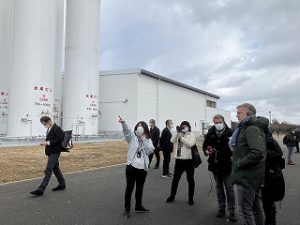
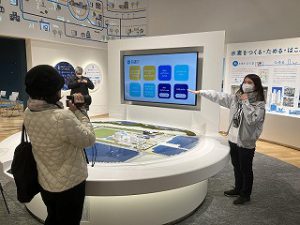
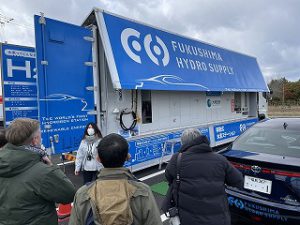
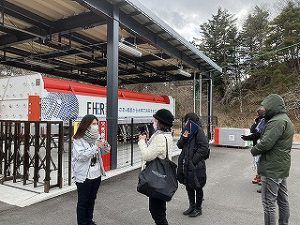
<Interviews with Okuma Residents ②>
The tour visited Kuma Pre, a center for community exchange which opened last year near JR Ono Station, which was busy as the town center before the earthquake and spoke with a married couple who are staff there, Ms. YOSHIDA Yukie and Mr. YOSHIDA Kiichi. The journalists heard what the area, where evacuation orders were lifted in June 2022, looked like before the disaster, and were shown pictures and dioramas while listening to future construction plans. They also heard from the Yoshidas, who are still evacuated because their home in Okuma is in “Restricted area”, about their feelings regarding returning home and their hopes for the future of Okuma.
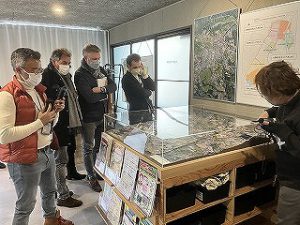

<Discussion with Young Okuma Town Employees>
The tour heard from Mr. SATO Kazuhiro and Ms. SATO Yuka, members of the Okuma Furusato Mirai Kaigi (Okuma Hometown Future Council), which was made after the earthquake by young town employee volunteers. The journalists asked questions about differences in perspective on the town’s reconstruction between younger and older town employees, and about why they personally decided to return to Okuma.




